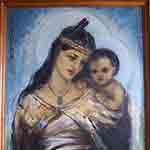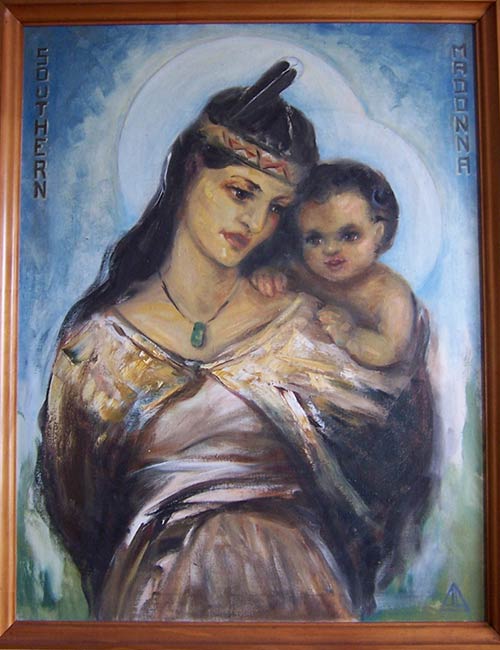Today, August 15, churches celebrate Mary, the mother of Jesus. The day has many titles: The Assumption, the Dormition, the Feast of the Blessed Virgin Mary… In some places the feast is regarded as so special that it is moved to Sunday (or, one might argue, it is not regarded as special enough, and there’s a fear that not enough will turn up to celebrate the feast on a Tuesday…)
The origin of the feast day of the Blessed Virgin Mary on August 15 is unknown.
My reflection on Mary the mother of Jesus includes:
Mary (“Miriam”) bears the same name as Moses’ sister. A strong woman. She is married to Joseph. The names of the rest of the family are also strong names recollecting their early history of liberation. Jesus (Joshua = “God saves/liberates/sets free”), James (Jacob), Joseph, Simon (Simeon), Judas (Judah), (Matthew 13:55). And, yes, we know Jesus had at least two sisters. It also tells a story that we don’t know their names.
Does your family go in for royal names (George, James, Henry, William, Elizabeth, Anne)? Famous sportspeople? Jesus’ family seemed to choose early liberation names. Jesus’ family chose names from the foundational deliverance stories of their nation. You can imagine what the Roman oppressors thought of people with names like this.
When the new Joshua (Jesus) crosses the Jordan (baptism) from the far side (Jn 1:28), re-entering the Promised Land, one can imagine the emails that hit Pontius Pilate’s PC from the equivalent of MI5 or the SIS. The strong Miriam-Mary and her family were a group to keep an eye on.
On a previous blog post for this feast, The Blessed Virgin Mary, there are some quotes worthy of reflection from Mary: Grace and Hope in Christ – joint statement of the Anglican – Roman Catholic International Commission (ARCIC):
The dogmas of the Immaculate Conception and the Assumption raise a special problem for those Anglicans who do not consider that the precise definitions given by these dogmas are sufficiently supported by Scripture….
In the East the feast was known as the ‘dormition’, which implied her death but did not exclude her being taken into heaven. In the West the term used was ‘assumption’,which emphasized her being taken into heaven but did not exclude the possibility of her dying….
One consequence of our separation has been a tendency for Anglicans and Roman Catholics alike to exaggerate the importance of the Marian dogmas in themselves at the expense of the other truths more closely related to the foundation of the Christian faith. Anglicans and Roman Catholics agree that the doctrines of the Assumption and the Immaculate Conception of Mary must be understood in the light of the more central truth of her identity as Theotókos, which itself depends on faith in the Incarnation. We recognize that, following the Second Vatican Council and the teaching of recent Popes, the Christological and ecclesiological context for the Church’s doctrine concerning Mary is being re-received within the Roman Catholic Church. We now suggest that the adoption of an eschatological perspective may deepen our shared understanding of the place of Mary in the economy of grace, and the tradition of the Church concerning Mary which both our communions receive. Our hope is that the Roman Catholic Church and the Anglican Communion will recognize a common faith in the agreement concerning Mary which we here offer. Such a re-reception would mean the Marian teaching and devotion within our respective communities, including differences of emphasis, would be seen to be authentic expressions of Christian belief….
As a result of our study, the Commission offers the following agreements, which we believe significantly advance our consensus regarding Mary. We affirm together
– the teaching that God has taken the Blessed Virgin Mary in the fullness of her person into his glory as consonant with Scripture, and only to be understood in the light of Scripture (paragraph 58);
– that in view of her vocation to be the mother of the Holy One, Christ’s redeeming work reached ‘back’ in Mary to the depths of her being and to her earliest beginnings (paragraph 59);
– that the teaching about Mary in the two definitions of the Assumption and the Immaculate Conception, understood within the biblical pattern of the economy of hope and grace, can be said to be consonant with the teaching of the Scriptures and the ancient common traditions (paragraph 60);
– that this agreement, when accepted by our two Communions, would place the questions about authority which arise from the two definitions of 1854 and 1950 in a new ecumenical context (paragraphs 61-63);
– that Mary has a continuing ministry which serves the ministry of Christ, our unique mediator, that Mary and the saints pray for the whole Church and that the practice of asking Mary and the saints to pray for us is not communion-dividing.
Do also look at Mary Consoles Eve.
The image at the top of this post is that of The Southern Madonna, by Julia Lynch (Sister Mary Lawrence of the Trinity RSM). It hangs in the church at Southern Star Abbey, Kopua.
What resources, thoughts, reflections can you add to enrich the lives of those who gather around this site? Please add them in the comments.
The sermon today preached by Fr Richard Peers at the Mass celebrating the Assumption at All Saints Margaret Street, London is found here.
If you appreciated this post, consider liking the liturgy facebook page, and/or signing up for a not-very-often email, …





There is a very good reflection and a beautiful painting here from Bishop Steve Lowe.
https://www.facebook.com/permalink.php?story_fbid=1379368225511884&id=725562827559097&pnref=story
Many Blessings
Thanks, Chris. Blessings.
Dear Bosco,
As an Ango-Catholic, I have no difficulty with the possibility of Mary being assumed into heaven. After all, this is attested in Scripture to have been the trajectory of the Prophet Elijah. Comparing the two heroes, was not the Mother of Christ at least equally worthy of this ‘elevation’?
On the other hand, I have a problem, theologically, with the prospect of Mary’s ‘Immaculate Conception’. If this were the case, Jesus was born of a woman who was, herself ‘without sin’. How would this have helped in the understanding that Jesus ‘took upon himself our sinful human nature and redeemed it’?
To my mind, the legendary statement of Our Lady at Lourdes might better have been, not: “I am the Immaculate Conception” but rather: “In me was the Immaculate Conception (of Jesus)”.
Whatever the understanding of Our Lady’s place in salvation; without her resounding “YES”, there might have been no Incarnation of Christ, through whom, alone, we have been and are redeemed.
Hail to you, O Queen of Heaven, Alleluia.
He whom you were meet to bear, Alleluia –
As He promised has arisen, Alleluia;
Pour for us to Him your prayer, Alleluia.
Rejoice and be glad O Virgin Mary, Alleluia!
For the Lord is risen indeed, Alleluia!
Thanks, Fr Ron. I think the bigger discussion that would be needed around Mary having been conceived without Original Sin, is to relook at the western Christian model of Original Sin inherited from St Augustine of Hippo. I think eastern Christianity has a lot to bring to this discussion. Blessings.
I’m not sure that taking upon himself our sinful human nature needs to go as far as Jesus himself being tainted by original sin. Therefore, to be human (as Jesus was and is) is not necessarily to be affected by original sin.
Perhaps Adam and Eve are also examples of this in their own right (pre fall) and also as signs of Jesus and Mary (hence the appropriateness of Mary being conceived without original sin).
In the assumption we see Mary as an example of our own future, which will also be free of original sin.
I see this as an evolutionary process, from our animal origins to our full humanity deified.
These two dogmas point us towards Mary, the perfect disciple and fearless prophet for the poor. She’s the example and intercessor our broken world desperately needs, and pondering on her way with her will lead us into a deeper and more authentic Christianity.
Many Blessings
Thanks, Chris – I especially appreciate your fourth paragraph. You may have spotted that I think deification is a too-neglected doctrine in our western tradition. Blessings.
I found this recent video of an icon of The Dormition – together with Orthodox Church music, that is worth a look at:
https://www.facebook.com/OrthodoxChristianChants/videos/2044898122409868/
Thanks, Fr Ron. A good introduction – but I am surprised the obvious mirroring of Christ holding Mary in the manner that, in other icons, Mary holds Christ, is not mentioned. Blessings.
Oh yes, the origin of this feast in known, and maybe we shall return to it. ( I have written a details article here: http://www.geocolas.be/Georges/2014/08/15/sourdants-del-fiesse-nosse-dame-d-awousse/ )
In short, the 9 of ab (mid-August) is the Jewish day of remembrance of the destruction of the Jerusalem Temple both in 586 a. Ch., and 70 AD. The Judeo-Christians made a pilgrimage to Rachel’s Tomb, at Bir al-Qadismou pool, still attested in 417. The name of the pool gave “Kathisma” in Greek, which was then translated into Latin as “Dormitio beatæ Mariæ virginis”. The pilgimage was still popular, but its object was shifted. Later on, the Armenians used the word “verapokhoum” (“assumption”), which finally arrived in France centuries later.
The later legend about her dormition is pure fiction.
I think we should keep the traditional festivals, but with a hint to their original meaning.
I like very much the way the 15 August festival is named in both Walloon and Romanian, “Saint Mary the Great” (ro Sântã-Mãrie-Mare, wa Grande-Nosse-Dame), thereby avoiding both fictional legends and dangerous dogmata.
Thanks so much, George. As you might expect, I cannot read your post [Google Translate won’t even help – it won’t even recognise the language!] I love Jewish connections to Christian traditions – can you point us, please, to (English-language) scholarship of the connection between the Dormition and Tisha B’Av. Blessings.